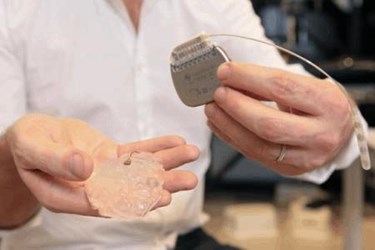Wireless Implant Overcomes Paralysis In Non-Human Primates

A wireless implanted system could one day bridge the gap between the motor cortex of the brain and the lower extremities of people paralyzed by injuries to the spinal cord. In a proof-of-concept study, an international team of researchers demonstrated restored locomotion in temporarily paralyzed non-human primates using wireless sensors and spinal stimulation.
In a study published in Nature, the authors describe previous research that has used brain-computer interfaces to restore grasping capabilities after hand paralysis, and electrical stimulation to restore leg muscle activity in rats. Building on previous research, the scientists believed similar strategies could restore leg muscle activity well enough to correct gait deficits, but “replicating the complex sequence of individual muscle activation patterns underlying natural and adaptive locomotor movements posed formidable conceptual and technological challenges.”
The research team, which included scientists from Brown University, Medtronic, and the Ecole Polytechnique Federale Lausanne (EPFL) in Switzerland, used implanted brain sensors and wireless transmitters to map walking motion in rhesus macaques. The team then developed a system that could record appropriate signals in the motor cortex and transmit them to a stimulation system implanted in the spine attached to nerves that trigger walking functions.
“Signals recorded from the motor cortex of the brain trigger coordinated electrical stimulation of nerves in the spine that are responsible for locomotion,” said David Borton, assistant professor of engineering at Brown and one of the study’s co-lead authors, in a press release. “With the system turned on, the animals in our study had nearly normal locomotion.”
In 2009, Borton was part of a team led by Arto Nurmikko, which developed a neurosensor capable of recording non-human primate motor cortex signaling. Borton commented that wireless sensors allowed scientists to map neural activity within the normal contexts of natural behavior, which could be critical to the development of advanced prosthetics.
Gregoire Courtine, a professor at EPFL who led the collaboration that developed the system, told the New York Times that it is unlikely that the system could be used as a “fix-it” for paralyzed patients—at least not any time soon. Evidence does suggest that the system could be a valuable tool used in rehabilitation.
“There’s an adage in neuroscience that circuits that fire together wire together,” said Borton. “The idea here is that by engaging the brain and the spinal cord together, we may be able to enhance the growth of circuits during rehabilitation. That’s one of the major goals of this work and a goal of this field in research.”
“There are many challenges ahead and it may take several years before all the components of this intervention can be tested in people,” said Courtine, who added that future studies would further evaluate animals’ balance and weight distribution using the system.
Next-generation prosthetics and exoskeletons are using brain-machine interfaces (BMIs) by connecting machines to the neural circuitry that controls limbs. UCLA scientists are investigating spinal cord stimulation as a non-invasive therapy for paralyzed patients. Researchers at Duke University recently demonstrated that “brain training” could restore partial sensation and movement to paralyzed limbs.
Scientists from the University of Washington are working on an implant that could reroute the brain signals of patients who’ve suffered spinal injury or stroke, and believe their device could be ready for clinical trials within the next decade.
